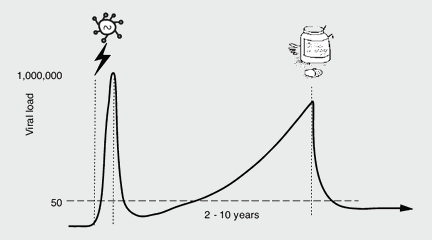2. 6 Viral load in early and chronic infection
The natural history of an illness describes the pattern of a disease if it is not treated.
It is important to know about the natural history of HIV.
Natural history of HIV
The natural history of HIV infection has several different stages.
These stages include:
- Infection.
- Seroconversion.
- Primary infection.
- Chronic infection.
- Late-stage illness.
HIV treatment (ART) stops most HIV-related illnesses and infections.
Infection
This is when HIV gets into your body and infects the first cells.
- It then takes several hours for these newly infected cells to carry HIV to the lymph nodes.
- During the next few days or weeks, HIV continues to multiply in the lymph nodes closest to the infection. After sexual transmission, this will be lymph nodes near your groin.
- Lymph nodes contain CD4 cells that are either active or asleep. Active cells allow HIV to replicate.
Seroconversion
After building up in the first infected lymph nodes, these nodes burst, sending HIV into the blood.
This sends HIV throughout the body. HIV levels (viral load) become detectable in blood and reaches very high levels (often millions of copies/mL).
As viral load increases, this high level of viral activity produces symptoms in up to 80% people. These seroconversion symptoms include night sweats, fevers, weakness and tiredness and, more rarely, mouth ulcers.
The immune system reacts to viral load in the blood by producing antibodies to fight HIV. It usually takes 1-3 months after infection for HIV antibodies to be strong enough to be detected on an HIV antigen test. Occasionally this can take longer.
Primary (HIV) infection – PHI
PHI is also called early infection or acute infection.
Primary infection describes the first six months after infection.
Chronic infection
Chronic infection describes HIV infection after the first six months.
Without ART, it can take from 2-10 years until most people get HIV-related symptoms.
With ART, chronic infection can be life-long – ie 20, 30, or 40 or more years after infection.
Late stage infection
Late stage infection is the most serious stage.
Late stage HIV is now more rare.
- It is only seen in people who are either diagnosed very later or who do not have access to ART, or who do not use ART.
- It is also seen when treatment has stopped working because HIV has become resistant to drugs.
- Late-stage HIV used to be called AIDS, but the term AIDS is now rarely used.
Effect of ART on viral dynamics of HIV infection
After starting ART, viral load should go down by at least 90% (1 log) within the first week – mostly in the first few days.
After starting ART viral load should then become undetectable (less than 50 copies/mL) within three months. Some people become undetectable after only a month. For some people this takes longer.
How quickly viral load becomes undetectable depends on three main factors.
- How high viral load is when ART is started.
- How good someone is at taking their meds and not missing doses.
- Which HIV drugs are in the combination. Integrase inhibitors reduce viral load quicker that other types of HIV drugs.

- A few weeks after infection, HIV viral load shoots up to very high levels. This is when someone is most infectious.
- Then your body fights back. Viral load drops to much lower levels in most people.
- Without ART, over the next 2-10 years viral load increases slowly. Viral load usually becomes very high (around 50,000-200,000 copies/mL) by the time the CD4 count drops to 350 cells/mm3.
- All treatment guidelines should now recommend ART for all people living with HIV.
- ART stops HIV stops reproducing once viral load becomes undetectable.
After ART brings viral load down to less than 50 copies/mL, treatment can continue working for many years.
Last updated: 1 January 2023.
